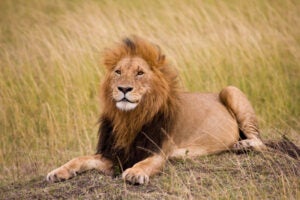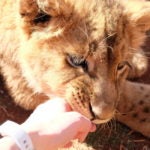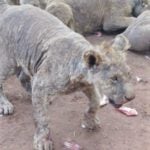
CAPE TOWN—South Africa is not a good place for lions today, on World Lion Day—and it won’t be tomorrow either, with an estimated 11,000 lions held captive in more than 300 facilities across the country. The captive lion breeding industry is marked by ongoing exposure of poor conditions and welfare standards, inhumane slaughter and pending cruelty cases.
“Like the pitiful circuses of old, the clock is ticking for this abusive industry, and the South African government should be doing more to hasten its end,” said Audrey Delsink, wildlife director for Humane Society International/Africa. “As consumers become increasingly aware of the cruel and exploitative practices in captive lion breeding and its spin-off industries, taking concrete steps to shut down this profit-driven, putrid trade would be a fitting way to honour World Lion Day.”
In addition to serious welfare and conservation concerns, COVID-19 has also placed a spotlight on infectious disease outbreaks linked to the wildlife trade.
“In captive breeding facilities, many lions are confined under unhygienic, stressful conditions, and they are often slaughtered on site, creating ideal conditions for the spread of zoonoses,” said Delsink.
There are almost four times more lions in cruel captivity in South Africa than there are in the wild. The country is home to only 3,000 wild lions.
The captive lion industry has no conservation value and is believed to be contributing to the growing demand for body parts of big cats and threatening global populations of other big carnivores—including tigers who are bred, slaughtered and hunted along with lion. The World Wildlife Crime Report issued in May 2020 by the United Nations Office on Drugs and Crime stated that illicit markets in big cats raise conservation concerns for the species.
The industry’s associated activities—such as cub petting, lion walking, ‘canned’ hunting and the trade in lion bone and other body parts—have continued despite the 2018 Parliamentary Colloquium that led to a committee resolution calling for the closure of the industry.
HSI/Africa provided an extensive submission to the high-level panel commissioned by the Minister of Environment, Forestry and Fisheries Barbara Creecy to inform state policy on the management of lions, leopards and other wild animals in the country.
HSI/Africa called on the panel to take the following actions:
- Implement the directives of the Parliamentary resolution addressing captive lion breeding without further delay;
- Place an immediate moratorium on new captive lion breeding facilities or further breeding at existing lion facilities;
- Place a moratorium on the international import and export of live animals and animal parts, pending an independent investigation into allegations of CITES and local regulation non-compliance; and
- Engage with the Department of Agriculture, Land Reform and Rural Development to repeal recent amendments to legislation that facilitate the management of wild animals as farm animals, and the slaughter and consumption of lion and other wild animals as human food.
Tourists are often not aware that South Africa’s wildlife ‘entertainment’ facilities are linked to canned lion hunting, and many such facilities dupe unsuspecting tourists into spending time and money on volunteering at these places under the guise of ‘conservation’.
Trophy hunting
Lions exist in only 8% of their former range and are suffering from loss of habitat and prey, in addition to being decimated by trophy hunting.
HSI analysis of CITES trade data shows that between 2017 and 2018, the European Union imported 398 lion trophies, while the United States imported 150. Of the 406 EU trophies, 312 were from captive lion hunting facilities in South Africa.
Despite claims that the captive predator breeding industry and trophy hunting of captive-bred lions is a significant contributor to the economy, the contribution to South Africa’s GDP is marginal and benefits only a few. A recently published paper estimates that total gross revenue for the sub-sector is estimated at roughly USD $180 million per annum. These revenues represent a mere 0,96% of tourism’s total GDP contribution in 2019 (USD $18.8 million) but may entail extensive opportunity costs. The reputational damage to South Africa and the cost to its tourism is a far-greater risk than the country can afford as consumers increasingly seek out ethical tourist destinations around the world.
Panthera leo is classified by CITES as endangered, listed as Vulnerable by the International Union for Conservation of Nature and is also listed in the U.S. Endangered Species Act.
ENDS
Media contact: Marisol Gutierrez, HSI-Africa media and communications manager, +27 72 358 9531, mgutierrez@hsi.org




